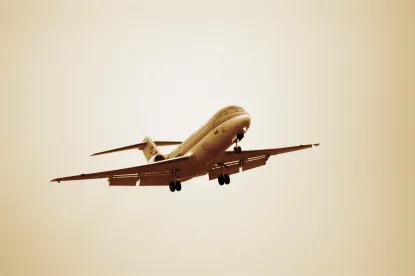Following a surge of investment in China’s general aviation sector around 2013, the sector has experienced down-turns due to the overall slowing of the economy in 2015. On May 17, 2016, the General Office of the State Council announced a guideline to boost China’s general aviation (“GA”)[1] industry, named the Guiding Opinions to Promote the Development of the General Aviation Industry (Guo Ban Fa [2016] No. 38) (“Guideline”). The Guideline marks the first time the state council, the highest administrative organ, has made plans to boost the development of China’s GA industry[2].
The Guideline describes the status of China’s GA industry as of 2015 stating:
“the scale of the GA industry was small, the infrastructure construction remained comparatively backward, the reform of the administration of low-altitude airspace progressed slowly, the GA industry lack the capability of independent R&D and manufacture, and there was still a big gap between the weak services and the consumer demands.”
In light of the above challenges, the Guideline has proposed detailed measures for the following five objectives:
1. Foster the GA Market
-
Develop short-distance transport businesses and encourage business aviation development to meet the demand for individualized high-efficiency travel services;
-
Increase applications of GA in public services (e.g. disaster relief and medical aid) and industrial, agricultural and forestry production activities; and
-
Facilitate integrated development between GA and tourism sports, the Internet and the creative economy.
2. Accelerate the Construction of GA Airports
-
Build GA airports in areas such as remote mountainous regions, areas prone to natural disasters, populated cities with serious traffic congestions, major agricultural producing areas, and world natural and cultural heritage sites, etc.;
-
Build GA airports in an economical and practical way;
-
Improve the approval procedures: the provincial counterparts of the National Development and Reform Commission (“NDRC”) should set out plans for building GA airports within its jurisdiction, and such plans should be permitted by the regional administrations of the Civil Aviation Administration of China (“CAAC”) and the theater air force. Further, the plans should be approved by the provincial government, and finally, the plans should be reported to the NDRC, the Ministry of Finance, the Ministry of Transportation, the CAAC, and the Joint Staff of Central Military Commission; and
-
Promote regional cooperation in metropolitan areas such as Beijing-Tianjin-Hebei, Yangtze River Delta Region and Pearl River Delta Region.
3. Promote Business Restructuring and Upgrade in the Industry
-
Advance the technology know-how of general aircraft manufacturing;
-
Establish general or special demonstration zones; and
-
Encourage the establishment of international GA R&D cooperation platforms and international GA engineering centers.
4. Further Open up Low-Altitude Airspace
-
Open up low-altitude airspace, particularly by achieving full liberation at 3,000m or below;
-
Simplify the approval procedures for GA flights: under the principles of the Guideline, the GA user is only required to submit its flight plans to a single air traffic controller for approval; and
-
Provide various time periods for submitting flight plans, for example, flights within one air traffic control area only need to submit plans four hours before takeoff, and the air traffic controller is required to respond within two hours before takeoff.
5. Enhance Safety Standards and Real-Time Monitoring
-
Enhance the airworthiness management through several measures. Specifically, the NDRC should be responsible for approving of manufacturing projects of general aircraft exceeding 6 tons/9 seats, the Ministry of Industry and Information Technology (“MIIT”) should set out the manufacturing standards of general aircraft such as drones, and the CAAC should improve and review the airworthiness standards of general aircraft;
-
Ensure the flight safety by holding various groups accountable. The CAAC is responsible to establish a real-time monitoring system of GA safety, the MIIT is responsible for managing the radio frequency of drones, the military is responsible for dealing with illegal flights in the air, and the public security department is responsible for dealing with illegal flights after landing; and
-
Regulate the GA market, including simplifying the approval procedures for importing general aircraft and promoting the construction of credit system within the GA industry.
In addition, ambitious goals with specific numbers are laid out in the Guideline. By 2020, China will increase the number of GA airports from 300 at the end of 2015 to 500 by 2020. The number of general aircraft is expected to grow from the current 1,874 to over 5,000, with annual flight hours exceeding 2 million. The Guideline aims to build a friendly environment for GA investors and eventually create a market worth more than RMB 1 trillion (USD 153 billion) by 2020.
Looking ahead, both domestic and foreign investors in China’s GA industry should expect to see more detailed and favorable policies from both the central and local government to implement the Guideline.
[1] General aviation and scheduled air transport are two pillars of the civil aviation industry. By definition, general aviation includes all non-scheduled civil flying, both private and commercial. More specifically, general aviation may include business flights, air charter, private aviation, flight training, ballooning, parachuting, gliding, hang gliding, aerial photography, foot-launched powered hang gliders, air ambulance, crop dusting, charter flights, traffic reporting, police air patrols and forest fire fighting.
[2] Closely following the Guideline, the European multinational aerospace manufacturer Airbus was reported to have signed a contract with a Chinese consortium, planning to set up an assembly line to build H135 helicopters in the West Coast New Area of Qingdao on June 13th, 2016. This is the first time that Airbus has its final assembly line established outside of Europe and Airbus predicts that China will soon fly past the United States as the world’s largest civil helicopter market.



 />i
/>i
